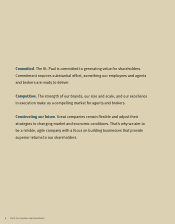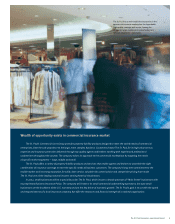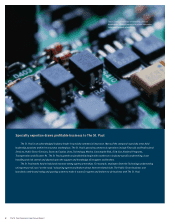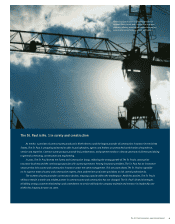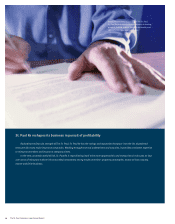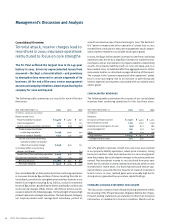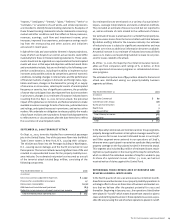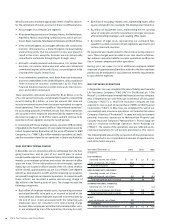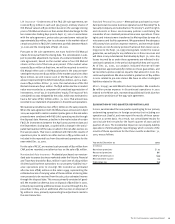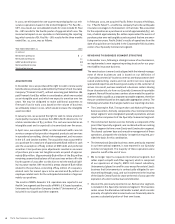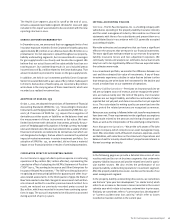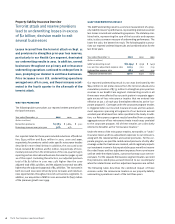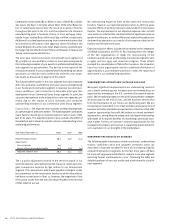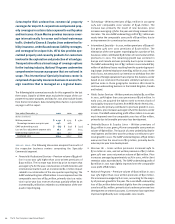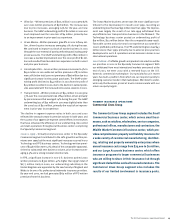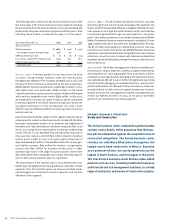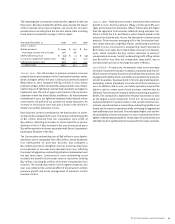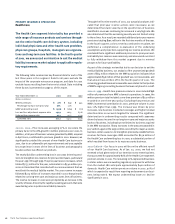Travelers 2001 Annual Report Download - page 18
Download and view the complete annual report
Please find page 18 of the 2001 Travelers annual report below. You can navigate through the pages in the report by either clicking on the pages listed below, or by using the keyword search tool below to find specific information within the annual report.
In 2000, we eliminated the one-quarter reporting lag for our rein-
surance operations based in the United Kingdom (“St. Paul Re –
UK”). As a result, our consolidated results for 2000 include St. Paul
Re – UK’s results for the fourth quarter of 1999 and all of 2000. The
incremental impact on our operations of eliminating the reporting
lag, which consists of St. Paul Re – UK’s results for the three months
ended Dec. 31, 2000, was as follows.
Year ended December 31 2000
(In millions)
Net written premiums $ 7
Net earned premiums 51
GAAP underwriting loss (10)
Net investment income 11
Total pretax income 1
acquisitions
In December 2001, we purchased the right to seek to renew surety
bond business previously underwritten by Fireman’s Fund Insurance
Company (“Fireman’s Fund”), without assuming past liabilities. We
paid Fireman’s Fund $10 million in consideration, which we recorded
as an intangible asset and which we expect to amortize over ten
years. We may be obligated to make additional payments to
Fireman’s Fund in early 2003 based on the volume of business
we ultimately renew in 2002, which would increase the intangible
asset recorded.
In January 2001, we acquired the right to seek to renew a book of
municipality insurance business from Willis North America Inc. for
a total consideration of $3.5 million. The cost was recorded as an
intangible asset and is expected to be amortized over five years.
In April 2000, we acquired MMI, an international health care risk
services company that provides integrated products and services
in operational consulting, clinical risk management, and insurance
in the U.S. and London markets. The acquisition was accounted for
as a purchase for a total cost of approximately $206 million in cash
and the assumption of $165 million of MMI debt and preferred
securities. Final purchase price adjustments resulted in an excess
of purchase price over net tangible assets acquired of approxi-
mately $85 million. (Approximately $56 million of the $64 million
remaining unamortized balance of that asset was written off in the
fourth quarter of 2001 after our decision to exit the medical liabil-
ity insurance market.) We recorded a pretax charge of $28 million
related to the purchase, consisting of $24 million of occupancy-
related costs for leased space to be vacated and $4 million of
employee-related costs for the anticipated elimination of approxi-
mately 130 positions.
The results of MMI’s domestic U.S. operations are reported in our
Health Care segment and the results of MMI’s U.K.-based operation,
Unionamerica Acquisition Company Limited (“Unionamerica”), are
included in our Lloyd’s and Other segment.
In February 2000, we acquired Pacific Select Insurance Holdings,
Inc. (“Pacific Select”), a California company that sells earthquake
insurance coverages to homeowners in that state. We accounted
for the acquisition as a purchase at a cost of approximately $37 mil-
lion, of which approximately $11 million represented the excess of
purchase price over net tangible assets acquired that we are amor-
tizing over ten years. Pacific Select’s results of operations from the
date of acquisition are included in the Catastrophe Risk business
center of our Specialty Commercial segment.
revisions to business segment structure
In December 2001, following a strategic review of our businesses,
we implemented a new segment reporting structure for our prop-
erty-liability insurance business.
The new structure is more closely aligned with the internal manage-
ment of these businesses and is based on our definition of
a “specialty commercial” business center as one that possesses ded-
icated underwriting, claims and risk control services requiring
specialized expertise and focusing exclusively on the customers it
serves. As a result, we have combined 11 business centers sharing
those characteristics to form our Specialty Commercial reportable
segment. None of these business centers alone meets the quantita-
tive threshold to qualify as a separate reportable segment; therefore
they are combined based on the applicable aggregation criteria. The
following summarizes the changes made to our reporting structure.
• The Catastrophe Risk, Transportation and National Programs
business centers, formerly components of our Commercial Lines
Group segment, were designated specialty operations and are
reported as components of the Specialty Commercial segment.
• The Construction business center, formerly a component of the
prior Other Specialty segment, was combined with our existing
Surety segment to form a new Surety and Construction segment.
The shared customer base and executive management of these
operations, along with the similarity in expertise required, pro-
vided the basis for this combination.
• The International Specialty business center, previously reported
in our International segment, is now reported in our Specialty
Commercial segment. The majority of these operations were
placed in runoff at the end of 2001.
• We no longer report a separate International segment, but
rather report a Lloyd’s and Other segment, which is comprised
of our operations at Lloyd’s, MMI’s U.K.-based subsidiary,
Unionamerica (placed in runoff in 2000 except for certain Lloyd’s
business that Unionamerica is contractually obligated to con-
tinue writing through 2004), and our involvement in the insuring
of the Lloyd’s Central Fund (to cease at the end of 2003 upon the
expiration of current contractual commitments).
•Discover Re, previously reported in our Reinsurance segment,
is included in the Specialty Commercial segment. This business
center serves the alternative risk transfer market, which consists
primarily of sophisticated insureds who are financially able to
assume a substantial portion of their own losses.
The St. Paul Companies 2001 Annual Report16


